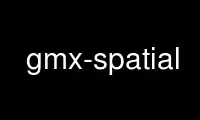
This is the command gmx-spatial that can be run in the OnWorks free hosting provider using one of our multiple free online workstations such as Ubuntu Online, Fedora Online, Windows online emulator or MAC OS online emulator
PROGRAM:
NAME
gmx-spatial - Calculate the spatial distribution function
SYNOPSIS
gmx spatial [-s [<.tpr/.gro/...>]] [-f [<.xtc/.trr/...>]] [-n [<.ndx>]]
[-b <time>] [-e <time>] [-dt <time>] [-[no]w] [-[no]pbc]
[-[no]div] [-ign <int>] [-bin <real>] [-nab <int>]
DESCRIPTION
gmx spatial calculates the spatial distribution function and outputs it in a form that can
be read by VMD as Gaussian98 cube format. For a system of 32,000 atoms and a 50 ns
trajectory, the SDF can be generated in about 30 minutes, with most of the time dedicated
to the two runs through trjconv that are required to center everything properly. This
also takes a whole bunch of space (3 copies of the trajectory file). Still, the pictures
are pretty and very informative when the fitted selection is properly made. 3-4 atoms in
a widely mobile group (like a free amino acid in solution) works well, or select the
protein backbone in a stable folded structure to get the SDF of solvent and look at the
time-averaged solvation shell. It is also possible using this program to generate the SDF
based on some arbitrary Cartesian coordinate. To do that, simply omit the preliminary gmx
trjconv steps.
Usage:
1. Use gmx make_ndx to create a group containing the atoms around which you want the SDF
2. gmx trjconv -s a.tpr -f a.tng -o b.tng -boxcenter tric -ur compact -pbc none
3. gmx trjconv -s a.tpr -f b.tng -o c.tng -fit rot+trans
4. run gmx spatial on the c.tng output of step #3.
5. Load grid.cube into VMD and view as an isosurface.
Note that systems such as micelles will require gmx trjconv -pbc cluster between steps 1
and 2.
Warnings
The SDF will be generated for a cube that contains all bins that have some non-zero
occupancy. However, the preparatory -fit rot+trans option to gmx trjconv implies that
your system will be rotating and translating in space (in order that the selected group
does not). Therefore the values that are returned will only be valid for some region
around your central group/coordinate that has full overlap with system volume throughout
the entire translated/rotated system over the course of the trajectory. It is up to the
user to ensure that this is the case.
Risky options
To reduce the amount of space and time required, you can output only the coords that are
going to be used in the first and subsequent run through gmx trjconv. However, be sure to
set the -nab option to a sufficiently high value since memory is allocated for cube bins
based on the initial coordinates and the -nab option value.
OPTIONS
Options to specify input files:
-s [<.tpr/.gro/...>] (topol.tpr)
Structure+mass(db): tpr gro g96 pdb brk ent
-f [<.xtc/.trr/...>] (traj.xtc)
Trajectory: xtc trr cpt gro g96 pdb tng
-n [<.ndx>] (index.ndx) (Optional)
Index file
Other options:
-b <time> (0)
First frame (ps) to read from trajectory
-e <time> (0)
Last frame (ps) to read from trajectory
-dt <time> (0)
Only use frame when t MOD dt = first time (ps)
-[no]w (no)
View output .xvg, .xpm, .eps and .pdb files
-[no]pbc (no)
Use periodic boundary conditions for computing distances
-[no]div (yes)
Calculate and apply the divisor for bin occupancies based on atoms/minimal cube
size. Set as TRUE for visualization and as FALSE (-nodiv) to get accurate counts
per frame
-ign <int> (-1)
Do not display this number of outer cubes (positive values may reduce boundary
speckles; -1 ensures outer surface is visible)
-bin <real> (0.05)
Width of the bins (nm)
-nab <int> (4)
Number of additional bins to ensure proper memory allocation
KNOWN ISSUES
· When the allocated memory is not large enough, a segmentation fault may occur. This is
usually detected and the program is halted prior to the fault while displaying a warning
message suggesting the use of the -nab (Number of Additional Bins) option. However, the
program does not detect all such events. If you encounter a segmentation fault, run it
again with an increased -nab value.
Use gmx-spatial online using onworks.net services
